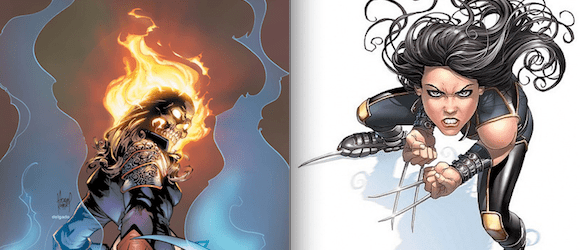If you’ve been following Things We Saw Today lately, you might have noticed some news tidbits on Marvel canceling two of its ongoing titles, X-23 and Ghost Rider. We were interested in the news because with the close of the two books, Marvel will no longer be running a comic that features a female character in a central starring role. The only women in Marvel’s titles are ones on teams, now. There are lots of things you can say about DC’s treatment of its female characters in the following titles, but at least you’ve got Batgirl, Batwoman, Catwoman, Wonder Woman, and Voodoo, not to mention the all female team of Birds of Prey. Okay, so that’s six out of fifty-two, but that’s six more comics with women in the titles than Marvel has now.
Tom Brevoort, Marvel’s Senior VP of Publishing, runs an active Formspring account and was recently asked quite boldly what he though Marvel’s responsibility was towards its female characters:
Q: Do you feel like you have a social (beyond financial) responsibility to feature more female (or other underrepresented minority) headliners in titles? EX: DC has Batgirl & Woman, Voodoo, Wonder Woman, but Marvel has no book named after&featuring a woman. :
I feel like we’ve got a social responsibility to feature characters of all kinds, but that doesn’t necessarily mean that those characters can or have to be headliners. That tends to be defined by the audience and the marketplace. If all of the fans crying for more series with female leads from all of the companies had supported all the ones that were done in the past, this circumstance wouldn’t exist. That said, that doesn’t change the responsibility, but ti[sic] may impact on the manner in which that responsibility plays itself out.
Lets parse this out a bit. “I feel like we’ve got a social responsibility to feature characters of all kinds,” but no responsibility to put women or minorities in prominent character roles or places of great visibility across our line, where they might best attract the kind of viewer looking for signs of diversity in a chronically bland industry. “If all of the fans crying for more series with female leads from all of the companies had” paid us more money for them, then we might have the motivation to do more.
That’s right, ladies. All we have to do to get a retailer to see us as a part of their audience is to spend money on them. But the money comes first, and in comparable quantities to the rest of the entrenched demographic that they are already focusing on to the exclusion of others, or no dice. This is absolutely how a shrinking industry should feel about attracting a new and potentially eager audience. It is absolutely not the opposite of the way this transaction is supposed to go. Companies in the business of giving product in trade for money always play hard to get with untapped demographics. That’s how you know the demographic wants you.
Maybe one of the reasons why women are generally (and I emphasize generally, knowing The Mary Sue’s audience!) uninterested in the Big Two is because their choices are a company where no female characters are in prominent roles comparable to their male counterparts, or one where they have to navigate a minefield of overt sexualization and inconsistent characterization of the women who are in prominent roles to find the titles that don’t outright offend them?
(Brevoort’s Formspring via The Beat.)








Published: Dec 7, 2011 11:44 am